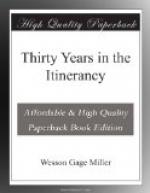One of the early laborers at Green Bay was Rev. George White, who came from Oneida Conference, N.Y. He was stationed at Green Bay in 1835, Brother Clark having been assigned to the Presiding Eldership. Under the labors of the new Pastor, the work continued to prosper. On the 2d day of February, 1835, Brother Clark reported to the Christian Advocate and Journal as follows: “Brother White is in the spirit of his work, and the Lord is blessing his labors in the conversion of souls, both in the Fort and among the citizens.”
The first Church enterprise was entered upon in 1836, when a lot was donated to the Society for the purpose of erecting a Church edifice. The Deed was given on the 6th day of September, 1836, by John Jacob Astor, Ramsey Crooks, Emily Crooks, Robert Stewart and Eliza Stewart, and was executed by James Duane Doty, their attorney. The Trustees of the Society, to whom the Deed was made, were Philip W. Nicholas, Francis McCarty, George White, Thomas P. Green, William White, Edwin Hart, and John P. Gallup. The edifice was completed during the year, but in the effort the Society became seriously involved, and were compelled to mortgage the property. The indebtedness hung as an incubus on the Society for ten years, and finally, through some strange mismanagement, the property was sold at a great sacrifice to the Roman Catholics.
At the session of the Illinois Conference, held Sept. 27, 1837, Rev. Philip W. Nicholas was sent to Green Bay, and Rev. Salmon Stebbins was assigned to the District. The congregations had now become highly respectable both in numbers and position. Hon. M.L. Martin had settled at Green Bay, and his good lady, who was a Methodist, had become a member of the Society. Sister Martin had been raised in affluent circumstances, and was a lady of fine culture and rare judgment. Her husband, a member of the legal profession, and subsequently a Delegate to Congress and Member of the Constitutional Convention of the State, was a man of good attainments and superior abilities. His family not only formed the nucleus of cultivated society, but also furnished a pleasant home for the Itinerant.
Besides this excellent and cultured family, the congregation embraced Col. Ryan and family, as before stated, Mrs. Gen. Brooke, and Mrs. Capt. Kirby Smith, whose husband was killed in the Mexican War, she being now the wife of Gen. Eaton, Quartermaster General of the U.S.A. In addition, Gov. and Mrs. Doty were constant attendants upon the Chapel, as were also Gen. and Mrs. Marcy, whose daughter, Mrs. George B. McClellan, was born here, and the most excellent of all the officers, Capt. Merrill and his young wife.
Referring to the class of society that constituted at first the class and congregation at Green Bay, reminds me of a case of Church discipline which occurred there about the days of which I am now writing. It happened on this wise:




